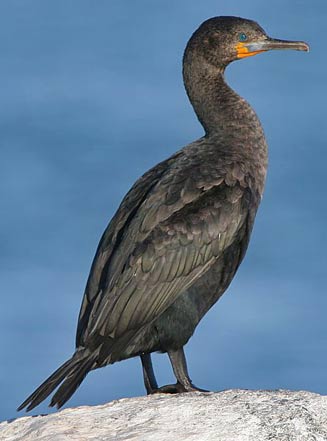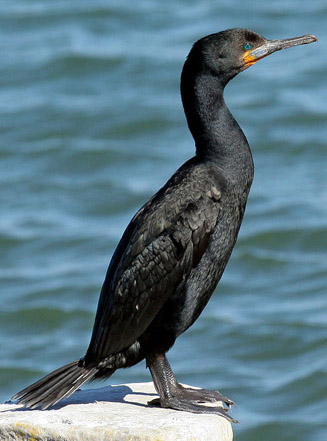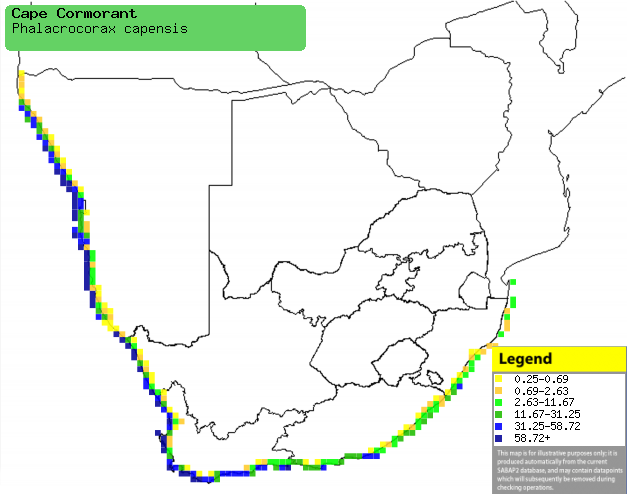Phalacrocorax capensis (Cape
cormorant)
Trekduiker [Afrikaans]; Ugwidi (generic
term for cormorants) [Xhosa]; Kaapse aalscholver [Dutch]; Cormoran du Cap
[French]; Kapkormoran [German]; Corvo-marinho do Cabo [Portuguese]
Life
> Eukaryotes >
Opisthokonta
> Metazoa (animals) >
Bilateria >
Deuterostomia > Chordata >
Craniata > Vertebrata (vertebrates) > Gnathostomata (jawed
vertebrates) > Teleostomi (teleost fish) > Osteichthyes (bony fish) > Class:
Sarcopterygii (lobe-finned
fish) > Stegocephalia (terrestrial
vertebrates) > Tetrapoda
(four-legged vertebrates) > Reptiliomorpha > Amniota >
Reptilia (reptiles) >
Romeriida > Diapsida > Archosauromorpha > Archosauria >
Dinosauria
(dinosaurs) > Saurischia > Theropoda (bipedal predatory dinosaurs) >
Coelurosauria > Maniraptora > Aves
(birds) > Order: Ciconiiformes
>
Family: Phalacrocoracidae
 |
 |
|
Cape cormorant, Brittania Bay, South Africa. [photo
Trevor Hardaker ©] |
Cape cormorant, Western Cape, South Africa. [photo
Jim Scarff
©] |
Distribution and habitat
Near-endemic to southern Africa, occurring along the coast
of Angola, Namibia, and the west coast of South Africa; it becomes increasingly
scarce as you travel east up the South-African coastline. It generally prefers
estuaries and coastal lagoons, roosting at areas with good protection from
predators, such as islands in wetlands or open beaches with good visibility.
|
 |
|
Distribution of Cape cormorant in southern Africa,
based on statistical smoothing of the records from first SA Bird Atlas
Project (©
Animal Demography unit, University of
Cape Town; smoothing by Birgit Erni and Francesca Little). Colours range
from dark blue (most common) through to yellow (least common).
See here for the latest distribution
from the SABAP2. |
Predators and parasites
- Predators
- adults and fledglings
- chicks and eggs
- Parasites
- lice
- Pasteurella multocida (Avian cholera)
- Ornithodorus capensis (tick)
- mites
- louse-flies (Hippoboscidae)
- Contraceacum (Nematodes)
Movements and migrations
Mainly sedentary, although it often disperses
after the breeding season.
Food
It mainly eats fish, doing most of its foraging in large
flocks 10-20 km offshore, although it rarely travels up to 80 km away from land. It catches prey by diving
from the water surface and giving chase, often resting at sea between foraging
bouts, unlike most other cormorants. This is because it is more buoyant and has
denser foliage, which does not get waterlogged. Its jaw is adapted to
handling small, fast-moving fish, so flocks often focus on large shoals of this
type. The following food items have been recorded
in its diet:
- Fish
- Sardinops sagax (Sardine)
- Trachurus trachurus (Horse mackerel)
- Engraulis encrasicolus (Anchovy)
- Sufflogobius bibarbatus (Pelagic goby)
- Merluccius (hakes)
- Crustaceans
Breeding
- Monogamous colonial nester, living in large, tightly packed colonies with
each nest fiercely defended by a breeding pair. Males fight for the right
to use a nest site by battling with each other with their bills.
- The nest (see image below) is mainly built by the female with material
provided by the male, consisting of a loose pile of sticks, feathers, dry
seaweed and sometimes other material, such as litter. It is typically placed
on offshore islands, cliffs, islands in coastal wetlands, artificial guano
platforms, moored boats and shipwrecks.
- Egg-laying season is year-round, peaking from August-February.
- It lays 1-4, rarely up to 7 eggs, which are incubated by both sexes in
shifts of about 1.2-3.5 hours.
- The chicks are cared for by both parents, leaving the nest at about five
weeks old. They swim in groups of up to ten until they fledge at 7-9 weeks
old, becoming fully independent several weeks later.
Threats
Near-threatened, as its population has decreased
from 277 000 pairs in 1977-1981 to just 72 000 pairs in 1996. This may be part
of a natural process, linked to the large natural variations in the population
of Anchovies (Engraulis encrasicolus). Human interference also has a
negative effect, often causing nest desertion and subsequent predation of chicks
and eggs.
References
-
Hockey PAR, Dean WRJ and Ryan PG 2005. Roberts
- Birds of southern Africa, VIIth ed. The Trustees of the John Voelcker
Bird Book Fund, Cape Town.
|
